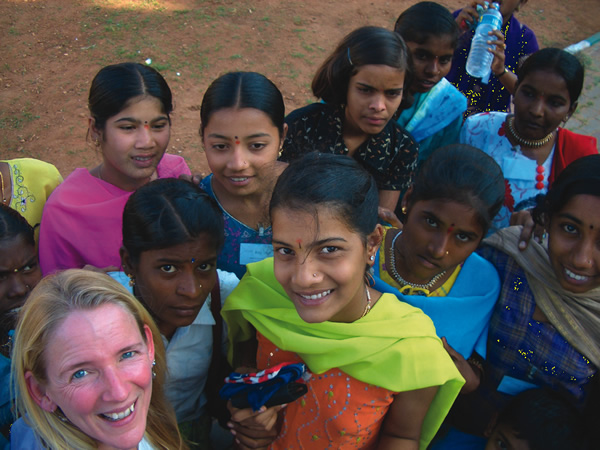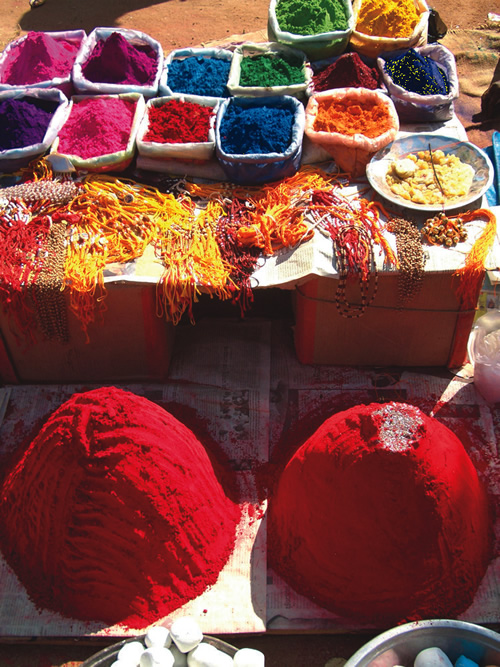How to Travel as a Women in India
Article and photos by Beth Whitman

|
|
The author pictured with a group of girls who were unaccustomed to seeing a blond woman.
|
The vastly diverse country of India is full of extremes. You witness immense beauty, yet utter filth. Some of countryside may seem barren, yet the cities and traffic are the densest on earth. The rich have unimaginable wealth and the poor can barely get by. Bollywood actresses dress seductively, yet the country as a whole is extremely socially conservative.
Because of this social conservatism, it’s important that women travelers educate themselves about India’s social mores and culture to best prepare for a safe journey.
During a month-long trip to India, I met many women traveling, with companions and in groups. Some were on short but expensive holidays, others were backpackers, and there were volunteers traveling for several months. Most of the women I encountered were respectful of the local customs, but some of these women behaved and dressed in ways that were insulting and disrespectful to the local Indian people. No doubt this disregard was largely due to ignorance rather than any intention to defy Indian traditions. The unintentional consequence of a lack of cultural insensitivity, however, not only affects how that individual may be treated by the locals, but also how other travelers who follow in their footsteps will be treated.
To avoid any missteps or cultural faux pas, here are some things women should take into consideration of as they travel around the magnificent country of India.
How to Dress in India
Dressing appropriately will set the tone of how you are received by the locals (and potentially other travelers) and will help ensure that unwanted attention and advances from men are kept to a minimum. Low cut, tight-fitting shirts, tank tops, skirts that fall above the knees, shorts and bikinis are totally inappropriate. While swimsuits can be worn in isolated beach resort areas such as Goa, women should still consider wearing a conservative one-piece and covering themselves with a sarong and t-shirt when not sunbathing or when interacting with locals. Short sleeve cotton shirts can be worn in warmer climates but they should be loose fitting and not revealing. Observe the locals and dress a bit more conservatively than the most liberally dressed woman.
Incorporate some of the local dress into your outfits by shopping once you arrive in-country. Purchase a locally made blouse or delicate scarf or shawl to wear over your Western-style clothes.
Consider buying a salwar kameez. The kameez itself is a loose-fitting blouse, often with half or long sleeves, that comes down past the waist or just above the knees. Salwars are loose-fitting pajama-like pants that are very wide at the top and very narrow at the ankles. A dupatta (long scarf) is often used as an accessory or for covering the head when need be. A full outfit can be purchased at many department stores, small boutiques or can be tailor-made (recommended if you are a large size as many clothes are made for small women) for a very reasonable price.
While saris are worn by all Indian women at one time or another, they are rarely worn by Western women, except for special occasions such as a wedding. A sari consists of a long length of fabric wrapped elegantly, and without pins, zippers or buttons, around the body and over a choli (a short sleeved and often midriff-baring top). While a choli may seem revealing to the Western eye because the stomach often shows, it should never be worn alone without a sari or other fabric covering it up. This would be akin to wearing just your bra outside your home.
While Bollywood beauties are seen in advertisements and movies wearing provocative clothing, the same low-cut or see-through-style blouses are off-limits to the rest of the population, and this means travelers, too.
Indian women take great pride in their beauty and take special care in choosing their attire. They’ll be noticed for what they are wearing and you will be, too. A gentleman who had just sold me more than $100 worth of silver jewels suggested that I wear something more Indian so that, even after two and a half weeks of travel, I didn’t look like I just got off the plane.

|
|
Powders on display for festival time in Hampi, when the walkways in front of houses are decorated with elaborate drawings made from these powders.
|
Safety
Generally speaking, India poses few problems for women travelers, despite some high-profile events that are widely reported. Victims rarely experience violent offenses but instead should be aware of opportunistic thieves. Your personal safety and the potential theft of your belongings will be your two main concerns.
To prevent sexual harassment, keep your arms folded in front of you in large crowds and on public transportation. It’s best not to initiate conversations that could be construed as flirtatious or personal and sidestep answering personal questions about yourself. If you’re traveling alone or with a female friend, invent a husband and make it clear that you are not interested in anyone else. Avoid situations where you may find yourself alone with a man. Connect with other travelers to share a taxi ride or tour and never let a man (including the bellhop or an employee delivering room service) into your hotel room under any circumstance.
If someone tries to initiate a sexual encounter and you are not interested, firmly decline and extract yourself from the situation as quickly as possible. If you are interested, be clear about his intentions and yours. Is this a genuine relationship or casual encounter? Know what you’re getting into and practice safe sex. According to the United States Agency for International Development (USAID), India is second only to South Africa in terms of the number of people living with HIV.
Beyond sexual harassment, you’ll want to ensure that your personal belongings are safe. Secure day bags or backpacks around your body (over your head and shoulder, or a strap threaded through your belt loop), lock zippers together, and wear a money belt, neck pouch, or leg pouch securely hidden underneath your clothes. When traveling on public transportation, lock your bags together with a cable lock and then to a stationary object such as a bench or immovable seat.
Probably the most common offense will simply be that you are financially taken advantage of by someone in the service industry. Taxi drivers, tour operators, and hotel desk clerks may attempt to overcharge you. Be clear beforehand what the cost of a service will be and shop around before agreeing on a price. Hiring a driver for a day may include a limited number of kilometers. Check the odometer before setting out. Ask if you are expected to pay for meals and hotel charges for your driver if you have an overnight stay and whether there is an additional charge for using the air conditioning. Examine all bills before you pay them so that you aren’t being charged for miscellaneous items you didn’t receive.
Packing
For your own safety, pack light. Train and bus travel are popular in India and with few bags you’ll be able to move quickly out of potentially nasty situations and you won’t have to keep an eye on too many items while in transit. Personally, I take one carry-on bag and one small day bag that gets tucked underneath the seat in front of me on the airplane.
I find that a roll-aboard bag that can be converted into a backpack is most convenient. It will allow you to pull your luggage through the airport or hotel lobby but quickly convert it into a backpack when you encounter steps or bumpy sidewalks. You’ll also be better received at a hotel in India if you have what looks like luggage rather than a backpack.
My day bag contains the essentials (camera, book, lip balm, tissues, pen, journal, light snack). A bag made of slash-proof material and strap is ideal.
Money
Lose the purse and carry a variety of currency options in at least two locations on your body. A small change purse carried in your pocket or day-pack should have enough small rupees to allow you to make purchases at a market or to pay for a taxi or auto rickshaw ride. Keep larger amounts of cash, your passport (or a copy of it), a credit card and debit card, as well as traveler’s checks in a money belt, neck pouch, or leg pouch.
Use your credit card for larger purchases (hopefully, you’re getting airline mileage on your credit card), your debit card to make cash withdrawals from an ATM, cash in U.S. dollars (including singles for tips) to use in an emergency or to change at a bank if an ATM is unavailable, and traveler’s checks as a backup. While traveler’s checks are not as popular as they once were, trust me, they can definitely come in handy during a power outage when ATMs won’t work and in small villages that don’t have cash machines.
Keep a copy of your traveler’s check numbers at home and in your luggage separate from the checks themselves. Carry the non toll-free number of your credit and debit card companies as you cannot make a toll-free call from abroad but you can call collect.
In the event that you are robbed, having a change purse will allow you to hand over a small portion of your money (and perhaps an invalid credit card, appeasing a thief) without giving away everything. Keep your valuables close at hand and never try to access your money belt in a public place.
Women travelers to India will encounter a more sexist attitude from the locals than they might in most Western countries. However, by acting and dressing appropriately, and following some simple guidelines for being safe, the journey will be rewarding!
Beth Whitman has hundreds of thousands of miles logged around the globe as a contemporary Wanderer: combining her love for travel with volunteer work, adventure trips, travel writing and business. Beth is the author of the Wanderlust and Lipstick series of travel guides for women, the editor of WanderlustAndLipstick.com. See Beth's bio for more on her books and upcoming tours.
|
